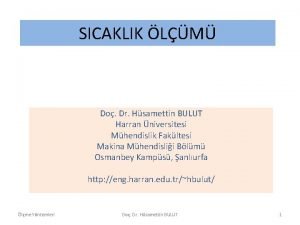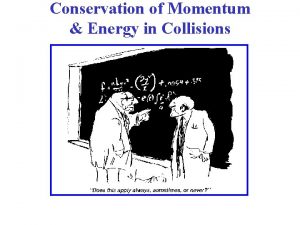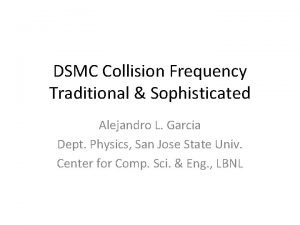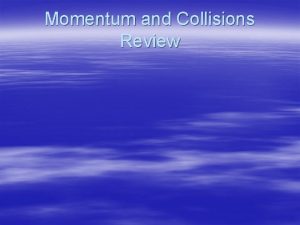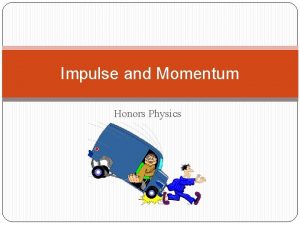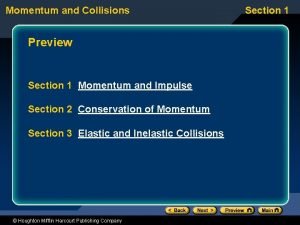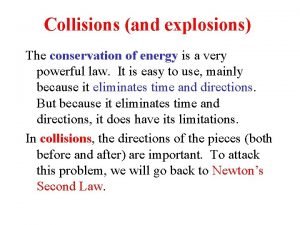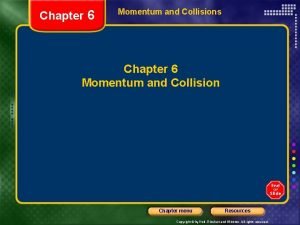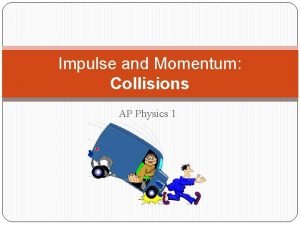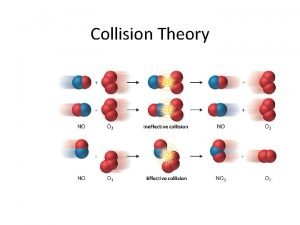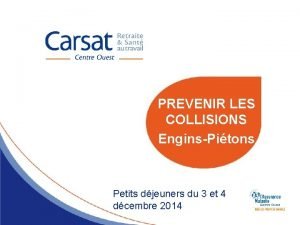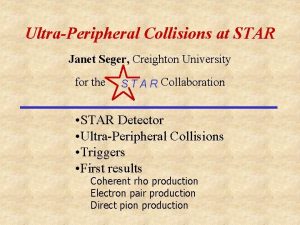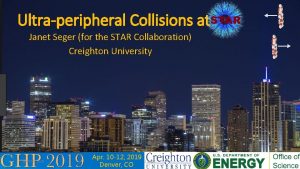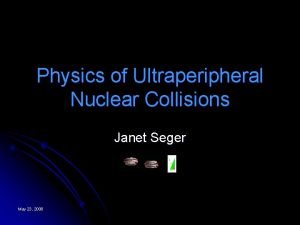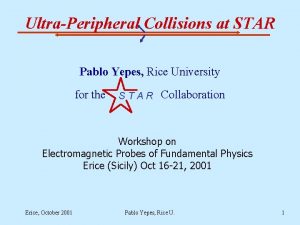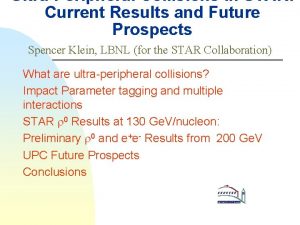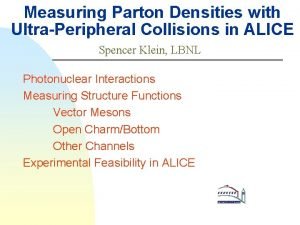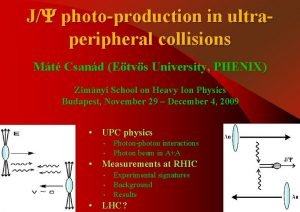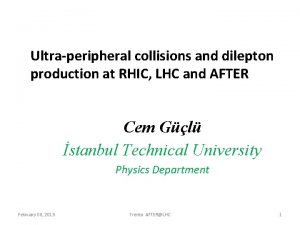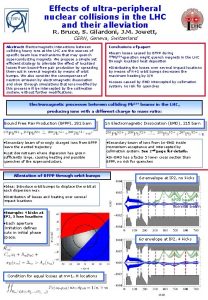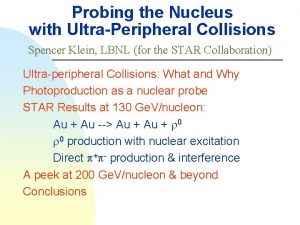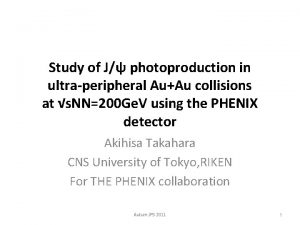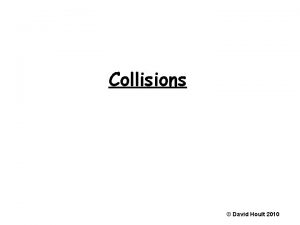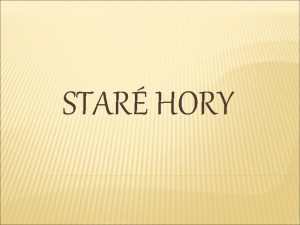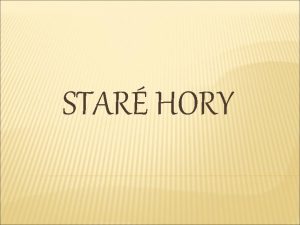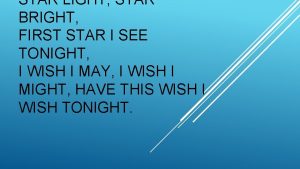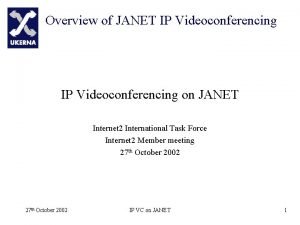Ultraperipheral Collisions at Janet Seger for the STAR



















- Slides: 19

Ultraperipheral Collisions at Janet Seger (for the STAR Collaboration) Creighton University April 11, 2019 Apr. 10 -12, 2019 Denver, CO J. Seger

Ultraperipheral Collisions • Large impact parameter(b > R 1 + R 2) no nuclear overlap no “collision” electromagnetic interactions dominate • Relativistic heavy ions are intense source of quasi real photons R 1 b > R 1 + R 2 • Q ~ 1/R ~ 0. 06 Ge. V (Au) or 0. 28 Ge. V (p) • Photon flux ~ Z 2 from each nucleus • Experimentally: very low multiplicity events with small momentum transfer, rapidity gaps • Photoproduction in gp and g. A interactions • QED processes in gg interactions April 11, 2019 J. Seger 2/19

Photoproduction of vector mesons • Has been extensively studied at HERA, RHIC, LHC • Factorize into • photon emission and • interactions with nuclear target • Allows probe of nucleus via QCD to learn about shadowing, saturation effects, n. PDFs • Coherent interaction: Photon interacts with entire nucleus • Nucleus generally remains intact • Small momentum transfer: p. T ~ ħ/RA ~ 15 Me. V • Max Photon energy ~ għ/RA ~ 3 Ge. V at RHIC • Incoherent interaction: Photon can interact with individual nucleons • Nucleus generally breaks • Momentum transfer is bigger: p. T ~ ħ/RA ~ 100 Me. V • Max Photon energy ~ għ/RA ~ 20 Ge. V at RHIC April 11, 2019 J. Seger 3/19

Heavy Vector Mesons: J/y • 2 -gluon exchange • Sensitive probe of gluon GPDs • For vector mesons, • Measurements at different rapidities sample different values of x April 11, 2019 J. Seger 4/19

The STAR detector • Central tracking and particle identification, forward counters and neutron detection • Time Projection Chamber: tracking and identification in |h| <1 • Time-Of-Flight: multiplicity trigger, identification and pile-up track removal • Barrel Electro. Magnetic Calorimeter: topology trigger and pile-up track removal • Beam-Beam Counters: scintillator counters in 2. 1<|h|<5. 2, forward veto • Zero Degree Calorimeters: detection of very forward neutrons, |h| > 6: 6 April 11, 2019 J. Seger 5/19

UPC trigger at STAR Trigger requires: • Back-to-back hits in BEMC • Limited activity in TOF • Veto from both BBCs • Signal in both ZDCs (xnxn) • Energy deposition within 1/4 to 4 beam-energy neutrons • Full efficiency for single neutrons April 11, 2019 J. Seger 6/19

J/y candidates observed in e+e- decay channel 200 Ge. V Au+Au data from 2014 run at STAR Selection criteria: • Vertex with exactly two tracks of opposite sign • |y| < 1 • p. T < 0. 17 Ge. V/c Like-sign background is minimal Non-negligible background from e+e- continuum is parametrized with empirical formula • Effective convolution of g g e+e- cross section and detector effects April 11, 2019 J. Seger 7/19

Transverse momentum of J/y candidates • Select candidates within J/y mass peak • Distribution is mostly well reproduced by template from Starlight for different contributions • e+e- normalized using mass fit • Discrepancy in region 0. 2 Ge. V/c < p. T < 0. 4 Ge. V/c April 11, 2019 J. Seger 8/19

Separate incoherent from coherent • Plot as a function of log 10(p. T 2) • Parametrize the incoherent contribution at high p. T (well above coherent peak) • Extrapolate to lower p. T and subtract to get coherent sample April 11, 2019 J. Seger 9/19

Diffractive dip seen in coherent ds/dtdy • After subtraction of incoherent contribution • t≈ - p. T 2 Model comparisons: • STARLIGHT: Klein, Nystrand, CPC 212 (2017) 258 -268 Slope below first diffractive minimum is consistent with the Glauber approach in STARLIGHT • Vector meson dominance and • Glauber approach • MS: Mäntysaari, Schenke, Phys. Lett. B 772 (2017) 832 -838 • Dipole approach with IPsat amplitude • Scaled to Xn. Xn using STARLIGHT • CCK: Cepila, Contreras, Krelina, Phys. Rev. C 97 (2018) no. 2, 024901 • Hot spot model for nucleons, dipole approach • Scaled to Xn. Xn using STARLIGHT Diffractive dip around |t| ≈ 0. 02 Ge. V 2 is correctly predicted by the dipole MS and CCK models April 11, 2019 J. Seger 10/19

Coherent rho photoproduction • High statistics 200 Ge. V Au+Au dataset • Like-sign background has been subtracted • Incoherent fit to dipole form factor at high t, extrapolated to lower t and subtracted to reveal coherent signal • Diffractive dips evident • Fourier-Bessel transform of ds/dt gives nuclear density profile Phys. Rev. C 96 (2017) 54904 April 11, 2019 J. Seger 11/19

Shadowing changes effective shape of nucleus • April 11, 2019 J. Seger 12/19

Data selection and mass binning • Exactly 2 tracks from a common vertex • |Zvtx| < 50 cm • |ypp| > 0. 04 (removes cosmic rays) • Each track has > 25 space points • 0. 62 Ge. V/c 2 < Mpp < 0. 95 Ge. V/c 2 • Divide into three mass bins of ~ equal statistic April 11, 2019 J. Seger 13/19

Subtract like-sign and incoherent backgrounds After subtraction of like-sign background Red: like-sign background Blue: opposite sign pairs April 11, 2019 Fit with dipole form factor J. Seger 14/19

ds/dt for Coherent rho mesons • After subtraction of incoherent contribution • Normalized to same number of events/Mpp bin • Depth of diffractive dip varies with mass April 11, 2019 J. Seger 15/19

Transform to F(b) • Use tmax = 0. 006 Ge. V 2 for baseline • Below first dip • Vary as systematic • If saturation is present, the profile will broaden, since absorption in the center cannot increase above one • In the black disk limit, F(b) would be constant • Expect lower-mass to be broader, flatter April 11, 2019 J. Seger 16/19

Windowing effect from choosing tmax • Choice of tmax affects the shape, particularly at b = 0 • Does not change the general trend that lower-mass wider distribution April 11, 2019 J. Seger 17/19

Starlight, for comparison • No shadowing effects included April 11, 2019 J. Seger 18/19

Conclusions • STAR has a high statistics sample of coherently produced rho mesons • • Allows clear observation of diffractive dips Shape of ds/dt sensitive to distribution of interaction sites Mpp serves as a proxy for dipole size Pilot study shows shape difference with mass (dipole size) • Systematic effects due to choice of tmax • Diffractive structure also seen in lower-statistics sample of coherently produced J/y • Location of diffractive dip in ds/dt consistent with dipole models • Slope of ds/dt at low t reproduced by Glauber model April 11, 2019 J. Seger 19/19
 Star of wonder star of night star of royal beauty bright
Star of wonder star of night star of royal beauty bright ısı sıcaklık farkı
ısı sıcaklık farkı Example of refractory materials
Example of refractory materials Returpilarna
Returpilarna A star and ao star algorithm
A star and ao star algorithm Star events stands for
Star events stands for Common velocity after collision formula
Common velocity after collision formula Collision frequency formula
Collision frequency formula A roller coaster climbs up a hill at 4m/s and then zips
A roller coaster climbs up a hill at 4m/s and then zips Impulse momentum relationship
Impulse momentum relationship Collisions
Collisions Is momentum conserved in all collisions
Is momentum conserved in all collisions Elastic vs inelastic
Elastic vs inelastic To avoid collisions a defensive driver should
To avoid collisions a defensive driver should Collisions and explosions
Collisions and explosions Chapter 6 momentum
Chapter 6 momentum Collisions ap physics 1
Collisions ap physics 1 Chapter 16 driving on highways
Chapter 16 driving on highways Necessary for successful collisions to occur
Necessary for successful collisions to occur Prévention des collisions engins-piétons
Prévention des collisions engins-piétons

